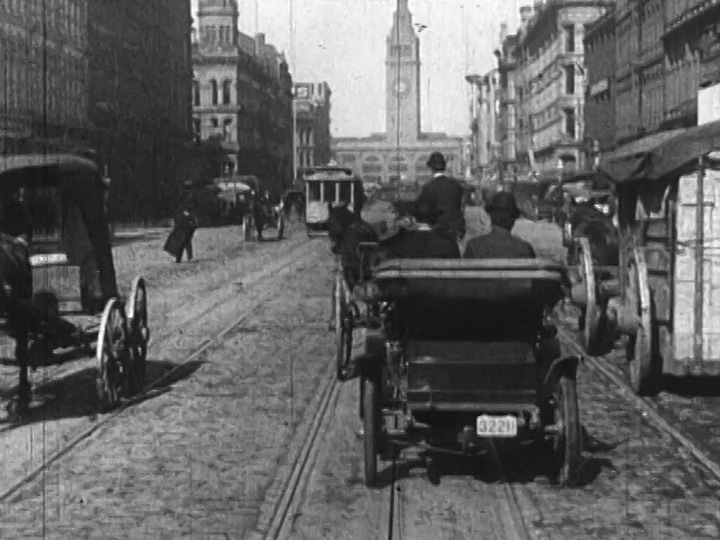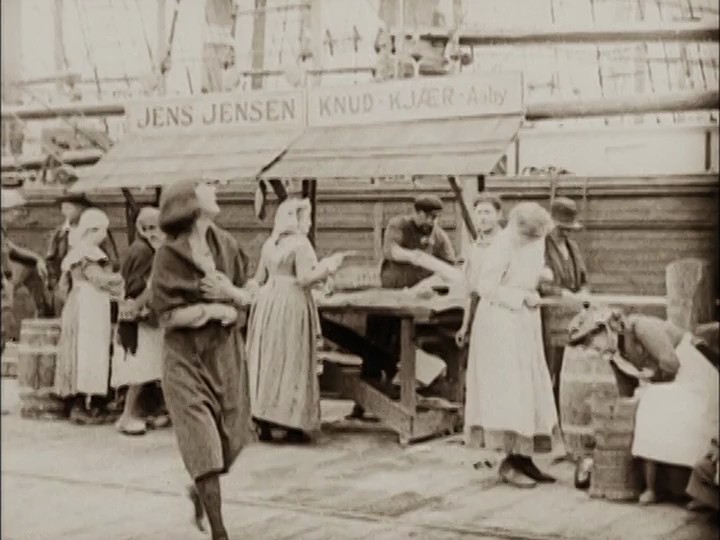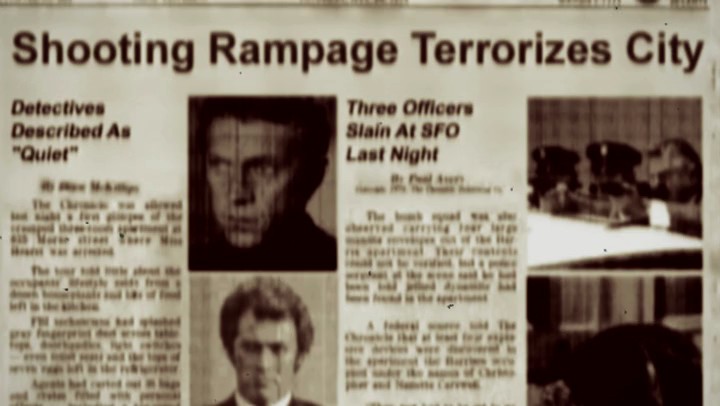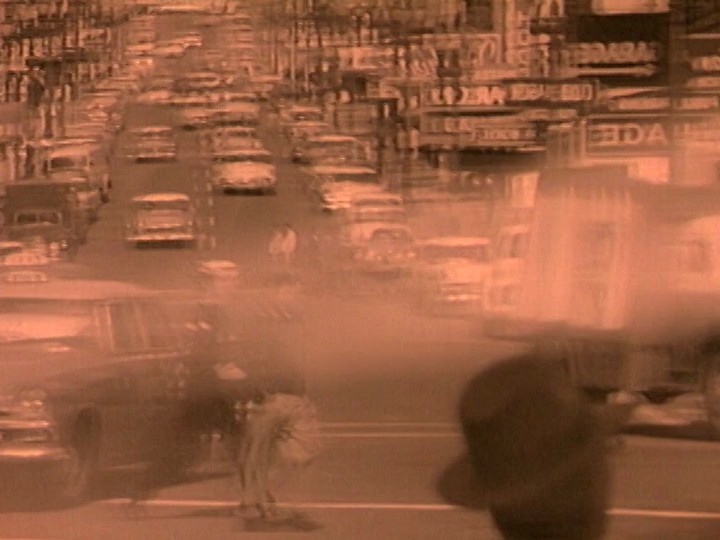San Francisco’s cinema pedigree is as pure as it gets, traceable back to the medium’s very genesis when Eadweard Muybridge photographed the world’s first moving images to prove Stanford White’s hunch that a galloping horse is at some point airborne. Made possible in part by the city’s head-of-a-pin geography, the coupling of creativity and capital has marked the movie industry ever since. Two decades later and the town almost becomes Hollywood but circumstances conspire and it becomes instead—and, as it turns out, more fittingly—a refuge for independents from Broncho Billy Anderson to George Lucas, along the way hosting talents as diverse as Charlie Chaplin, the Coppolas, and Craig Baldwin as well as a sizable number of documentary makers. With its unique topography and unmistakable architecture, San Francisco and its bucolic satellites also provided locations and settings for popular silent stars Mary Pickford and Douglas Fairbanks, the first films of Frank Capra, and the best of Alfred Hitchcock (Shadow of a Doubt through The Birds). For a century, it has been culturing the iconoclastic ideas of artists and entrepreneurs alike that are propelling the movies into their second full century. Whether the city, or more likely its close neighbors, can continue to cultivate innovation hand-in-hand with art depends on how the current residents choose to shape it.
1. A Trip Down Market Street (1906, dir. Harry Miles, 8 minutes)
The Miles Brothers pioneered the film distribution exchange, alleviating the expensive and constant burden on exhibitors to renew their catalogs by purchasing films outright from manufacturers, thus rendering exhibition sufficiently profitable. Harry, Herbert, Earle, and Joe also made their own films and opened the first movie studio on the West Coast at 1139 Market Street intending to add narrative films to their catalog of actualités. Watching (and no doubt hearing) the cable car rumble down the diagonal thoroughfare to the Ferry Building must have given them the idea to mount a motion picture camera in the front window and turn the train into their own personal dolly track, as they had done in 1902 on the Mt. Tamalpais railway. A hundred years on, the eight-minute film has not only become a document of San Francisco before the Great Earthquake but also a poetic piece of observational cinema. Newfangled automobiles pass quickly and directly in front of the camera and pedestrians dart dangerously and confidently in between the traffic, while the buildings that had gone up in a burst of Gold Rush wealth and go-west optimism stand mute in the face of these new technologies already transforming the city. On April 18, 1906, streets that a day before teemed with movement filled with stunned onlookers watching their city burn—see Films of the San Francisco Earthquake. The Miles Brothers’ brand new state-of the-art studio went down in the post-quake fires and with it San Francisco’s chance to become the nation’s movie capital.
2. Moran of the Lady Letty (1922, dir. George Melford, 68 minutes)
While the Los Angeles landscapes from scrub-covered hills to shiny sea coasts provided studios with a variety of backdrops for the expanding movie industry, the Bay Area still managed to attract movie makers as a locale and base of operations. Gilbert M. Anderson became Broncho Billy at Niles and the now forgotten Beatriz Michelena starred in and produced westerns and melodramas in San Rafael. Chaplin famously walked down the road along Alameda Creek at the end of The Tramp. The city’s then-undeveloped Sunset District served as the Algerian desert in 1921’s White Sands, by Hobart Bosworth, who had previously shot exteriors for The Sea Lion on the San Francisco Bay. Based on the 1898 novel by Frank Norris, whose books Eric von Stroheim adapted for his San Francisco masterpieces Foolish Wives and Greed, Moran of the Lady Letty is better known for star Rudolph Valentino than for its location. Fresh from the solid hit The Sheik, the Italian-born actor portrays a ballroom dandy transformed into a salty seadog after he’s shanghaied on Fisherman’s Wharf. Designed to draw macho moviegoers to the star’s loyal female fan base, the film marks Valentino’s return to San Francisco where he had only a few short years before gigolo-ed for his rent on O’Farrell Street and at the Cliff House. Besides the glimpses of Alcatraz, the waterfront piers when fisherman still outnumbered tourists, and the Golden Gate before there was a bridge (at about 6 minutes in), Moran of the Lady Letty also offers another San Francisco treat, the ‘she-sailor’ Moran, who bemoans her gender, saying “I ought to have been born a boy.” Even as she talks a tomboy talk, Dorothy Dalton doesn’t get to demonstrate much in the way of sea legs. However, her character resists Valentino, and the inevitable wearing of dresses, for as long as she can.
3. Treasure of Monte Cristo (1949, dir. William Berke, 78 minutes)
In William Berke’s concise noir, a navy officer gets shanghaied into onshore “service” and spends the rest of the film untangling the web woven by a damsel in seeming distress. With a lead character named Ed Dantes, there’s sure to be betrayal, incarceration, escape, and, especially, revenge, served up cold as gems. While the city’s noir chops come more from its literature than from the movies, it was used as a setting for some of the genre’s best known films. Doomed Edmond O’Brien runs down Market Street trying to catch his killer in D.O.A. Robert Mitchum sets up temporary shop in the city during his ill-fated idyll with the faithless Jane Greer in Out of the Past. Mostly, though, the economics of Hollywood’s crime dramas meant that a tree was a tree and a dark alleyway, a dark alleyway, so Sam Spade and the Thin Man didn’t set foot very often on an authentic San Francisco street. With Treasure of Monte Cristo, B-movie producer and Alameda native Robert Lippert proves the city’s streets to be noir worthy. A narrator sets the stage in a prologue panning the cityscape, barely any tall buildings breaking the horizon. “It’s not a town to be explained in statistics,” he explains. “For I’ve walked its streets and seen many strange things and heard many strange stories.” Among the film’s local highlights are the Ferry Building approached from a dark sea, the glowing baroque of a “Chop Suey” sign, the steep road winding up to Twin Peaks, and a still sandy Marina with Fort Mason dominating the view.
4. The Showdown (1975, dir. by J.X. Williams, 8 minutes)
Crime attracts not only the criminal but also the enforcer and where but San Francisco could two maverick cops feel more at home? Frank Bullitt and Harry Callahan immortalized the police who has to go rogue to do right. Which is tougher? They shoot it out in carefully edited side by side footage from each film, Bullitt (1968) and Dirty Harry (1971). Sniper-perch views of the Bay Bridge and the looming threat of Alcatraz are the only memorable landmarks we get a peep at in this mash-up, but the nondescript street backdrops remind of a time when the city served its coffee in vinyl-lined diners rather than posh cafés. That the short is credited to the fictitious director J.X. Williams in a prank played on film history only enhances its outsider status.
5. Visions of a City (1978, dir. by Lawrence Jordan, 6 minutes)
When James Broughton and Sidney Peterson debuted their film The Potted Psalm in 1946 at San Francisco’s Art in Cinema, it inspired the head of the California School of Fine Arts, now the San Francisco Art Institute, to add avant-garde film production to the school’s curriculum. Peterson taught the first course and he and his students collaborated on several of his subsequent projects. Broughton, who described the premiere as a “chilly disaster,” went on to author many more experimental works. A line can be drawn down the decades from Broughton and Peterson to Bruces Connor and Baillie, Nelsons Robert and Gunvor, Stan Brakhage, Chick Strand, and many others whose visual poetry found expression through the camera and optical printer. A prime mover in the validation of film as art, Lawrence Jordan cofounded the film society Camera Obscura, established The Movie, a 16mm experimental film theater in San Francisco, and taught at SFAI for 30 years. He shot Visions of a City in 1957, two years after beat-era poet Michael McClure read alongside Allen Ginsberg at the now legendary evening in October 1955 at Six Gallery. The film is a tour-de-force of photography and editing, as it captures McClure around town in a kaleidoscope of sepia-toned reflections. Not edited together by Jordan until 1978, the footage needed first to age. “I found that it was one of those rare films that I have always deplored the scarcity of: documents of how it really looked in a certain place in a certain years.”
6. Like It Is (1968, dir. by William Rotsler, 69 minutes)
Any history of San Francisco cinema should include a little grindhouse. Not only did Ivory Snow-faced Marilyn Chambers make her debut in the Mitchell Brothers’ Behind the Green Door, but art students added sex scenes to their school projects and sold them to grindhouses to pay the rent. The free-loving acid-dropping clothes-shedding hippie culture helped clear the way for porn acceptance in San Francisco and the marginalized genre has supplied Bay Area filmmakers with a way to support their documentary and/or art film habits. Rotsler, an illustrator who collaborated with Harlan Ellison on “The Kong Papers” in 1969, directed this strange hybrid that conflates the sexploitation and documentary genres. It features footage of actual Haight-Ashbury flower children dancing and drugging in Golden Gate Park and professionals prancing and grinding au naturel amid a visual cacophony of trippy special effects. It’s overlaid with recorded testimony from hippies and snippets of political speeches by everyone from Black Panthers on draft dodging to the governor bemoaning his “credibility gap.” But the viewer never loses sight of the film’s central meaning: if a little T&A is good, more must be better. As Eddie Muller and Daniel Faris explain about the convoluted genre: “grindhouse offered a bizarre bridge across the generation gap: it’s where Dad, the guy most repulsed by the rebellious antics of America’s hippie culture, paid several dollars to see just how free all that love really was.”










